There is currently a sustainable development debate over what the definition and practice of “sustainable architecture” is or should be. Of course, sustainable development in the Kurdistan Region of Iraq is quite different than in Southern California, but there are common elements. These days, many of the most talked about sustainable structures built in the United States are financed by wealthy businesses or individuals whose architectural creations cannot be duplicated on a wider scale by the middle class.
Defining Sustainable Architecture
The hallmarks of sustainable architecture include the use of recycled materials in construction, reduced energy consumption, passive heating and lighting, using the sun or wind as the primary source(s) of energy and air conditioning, and creating structures that prolong the aging process of a building. A typical sustainable house will have a roof covered with photovoltaic solar panels to heat water and provide off-grid power. Construction will include a design with cross-ventilation and argon-filled windows with low-emittance that provides ample natural light and prevents heat loss.
Sustainable architecture also minimizes the negative impact on the environment surrounding the building by making the structure as efficient as possible while moderating the use of land development space, materials, and energy. The structure is designed so that it fits into the site, the region, and the climate, and is harmonious with the needs of inhabitants.
New Methodologies, Tools & Applications for Sustainable Architecture
The US Bureau of Labor Statistics defines sustainable architecture and design as creating buildings that are environmentally responsible and resource-efficient. Also known as “green buildings,” sustainable buildings are now the focus of numerous undergraduate and graduate programs in science, energy, climate, and sustainable design.
Methodologies, tools, and applications needed for sustainable development and policies and strategies to promote and implement sustainable design are still in their infancy.
A report, “Introduction to Sustainable Design” by Jong-Jin Kim of the College of Architecture and Urban Planning at the University of Michigan, discusses the following topics related to sustainable architecture:
- The changing definitions of growth and progress. Bigger is not necessarily better, or as Joseph Shumpert wrote, “Small is Beautiful.”
- Resource consumption and environmental pollution. Every detail of resource consumption and environmental pollution must be tracked so that sustainability is achieved and resources are handled with economy.
- Lifecycle design – tracking all inputs and outputs from the birth of a new structure to its eventual demise.
- Humane design – taking into account the needs of people.
- Energy conservation.
- Water conservation.
- Materials conservations
- Preservation of natural environments.
- Urban design and site planning.
Following is a YouTube playlist with 15 videos on sustainable architecture:






